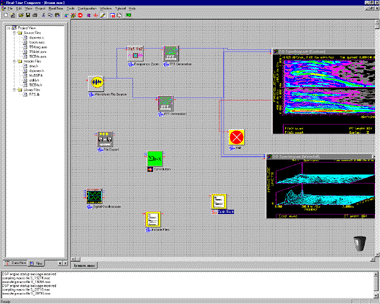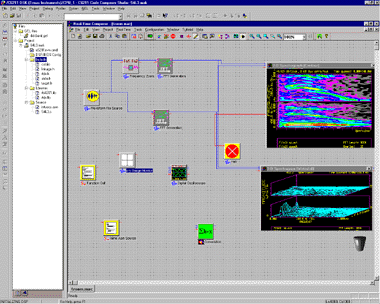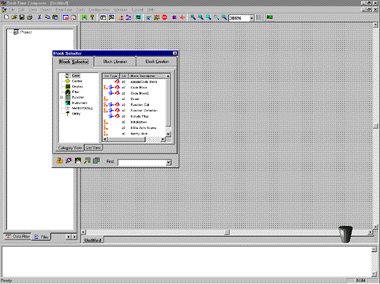
Real-Time Composer™ IDE with a diagram
open

Real-Time Composer™ plugin for Code Composer Studio with a diagram
open

Real-Time Composer™ IDE with the block selector open |
|
Overview
Real-Time Composer™ is a combination of the previous DSPower-Block Diagram and
DSPower-Real Time Code Generator software with several new features and improvements
added.
Real-Time Composer™ is an automated real-time code generator which can be used to generate real-time
executable code for DSP devices. It combines block diagram, data flow and sequence flow,
library of DSP, math, display, instrument and debug blocks, C code editing, and visual IDE
for DSP vendor tools into one integrated environment.
The package includes simulation, analysis, display, instrumentation and real-time code
generation for DSP devices. When generating code, Real-Time Composer™ first performs a dependency check on
all blocks, C/asm files, and other files (e.g. library files) in the project. The Real-Time Composer™ then
builds a linker control file and make file, and automatically controls the DSP tools (C
compiler, linker, and assembler) in the background. The result is an executable COFF file
which can be downloaded to a DSP/data acquisition board.
Real-Time Composer™ automates the process of making user-defined changes and additions to the
"base" DSP source code framework included with Real-Time Composer™ and DirectDSP®;
software. The base DSP code framework supports several default blocks, such as analog
input/output, common DSP functions such as FFT, correlation, digital filters, math
functions, and more.
Features Summary
Real-Time Composer™ allows the real-time buffer size (framesize) to be specified, and
automatically configures analog input/output properties in the base DSP code framework
depending on block setup parameters. Real-time framesize can range from 1 to 16384 or
higher, depending on amount of SRAM available on the DSP board. For example, a framesize
setting of 1 effectively invokes sample-based processing, which is common in some telecom
algorithms. Board-dependent analog I/O initialization, sample interrupts, dual-buffering,
and host-notification are handled automatically--all based on block setup parameters and
properties inside the visual environment.
Real-Time Composer™ also supports embedded "probe-point" and debug blocks,
including symbol (variable) readout, waveform display, and gauges and monitors.
Probe-point blocks can be used synchronously as part of diagrams, or asynchronously, in
which case they operate independently of the block diagram based on a specified update
rate (in msec). "Control surface" blocks are also provided, such as knob,
switch, etc. which can likewise be tied to symbol or variable names. |